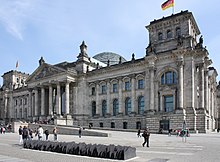Eugene Kaiser
Eugen Kaiser (born October 28, 1879 in Cleversulzbach ; † April 3, 1945 in Dachau concentration camp with typhus) was a German politician ( SPD ).
Origin and education
Eugen Kaiser's father, Christian Kaiser, ran the “Zum Löwen” inn in Cleversulzbach. After attending the local elementary school , Eugen Kaiser completed a horticultural apprenticeship in Neckarsulm from 1893 to 1896 . He then worked as a gardener's assistant until 1906.
Union and political activity
From 1906 to 1910 he took over the management of the General German Gardening Association, a free trade union organization. Around 1898 he joined the Social Democratic Party of Germany (SPD). After attending the trade union school from 1907, he became the workers' secretary in Frankfurt am Main and chairman of the Federal Youth Committee on June 1, 1910 .
From 1909 to 1921 he was chairman of the SPD in Greater Frankfurt am Main and on April 1, 1919, he was elected city councilor in Frankfurt am Main , a mandate he held until 1921. In the Reichstag election of June 1920 , Eugen Kaiser was elected to the first Reichstag of the Weimar Republic , to which he belonged until the election in May 1924 as a representative of constituency 21 (Hessen-Nassau). From 1922 Emperor was district administrator of the Prussian district of Hanau , an office that he held until 1933, when the new rulers initially retired on March 9, 1933 after the Nazis came to power , then dismissed him as a retirement official. After July 20, 1944 , he was arrested by the Gestapo in the " Operation Grid " and deported to the Dachau concentration camp in mid-September , where he was incarcerated with prisoner number 108221. The assumption that he died on the death march during the evacuation of the camp on April 4 has been refuted by recent research. According to the death register of the Dachau infirmary, Kaiser died of typhus on April 3, 1945 in Block 7 in the infectious disease infirmary.
Commemoration
It remind of him
- the memorial plaque near the Berlin Reichstag building , which is part of the memorial for 96 members of the Reichstag murdered by the Nazi regime ;
- the Eugen Kaiser School in Hanau , Hesse ;
- Street names in
- Bruchköbel
- Erlensee
- Hanau (here is the former Hanau district office with a memorial stone for Eugen Kaiser)
- Main valley
- Nidderau
- Schöneck
literature
- Georg-Wilhelm Hanna (edit.): The district of Hanau and its district administrators . Ed .: Kreissparkasse Hanau . Hanau 1989, p. 31.
- Barbara Nagel: Buried - but not forgotten. well-known personalities at Hanau cemeteries . Hanau 2008. ISBN 3-935395-12-4
- Martin Schumacher (Hrsg.): MdR The Reichstag members of the Weimar Republic in the time of National Socialism. Political persecution, emigration and expatriation 1933-1945. Droste-Verlag, Düsseldorf 1991, ISBN 3-7700-5162-9 , p. 318.
Web links
- Eugen Kaiser in the database of members of the Reichstag
- Kaiser, Eugene. Hessian biography. (As of February 5, 2020). In: Landesgeschichtliches Informationssystem Hessen (LAGIS).
Individual evidence
- ↑ Hanna.
- ↑ Hanna.
- ^ Frankfurter Allgemeine Zeitung, April 3, 2020, page 36
- ^ Martin Hoppe: Hanauer street names . Hanau 1991. ISBN 3-87627-426-5 , p. 84.
| personal data | |
|---|---|
| SURNAME | Kaiser, Eugene |
| BRIEF DESCRIPTION | German politician (SPD), MdR, district administrator |
| DATE OF BIRTH | October 28, 1879 |
| PLACE OF BIRTH | Cleversulzbach |
| DATE OF DEATH | April 4, 1945 |
| Place of death | on the evacuation march of the Dachau concentration camp |



